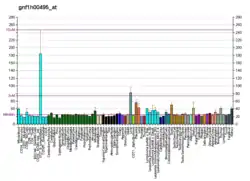SESN2
Sestrin-2 also known as Hi95 is a protein that in humans is encoded by the SESN2 gene.[5][6][7]
Function
This gene encodes a member of the sestrin family of PA26-related proteins. The encoded protein may function in the regulation of cell growth and survival. This protein may be involved in cellular response to different stress conditions.[7][8] The Sestrins constitute a family of evolutionarily-conserved stress-inducible proteins that suppress oxidative stress and regulate adenosine monophosphate-dependent protein kinase (AMPK)-mammalian target of rapamycin (mTOR) signaling. By virtue of these activities, the Sestrins serve as important regulators of metabolic homeostasis.[9] Accordingly, inactivation of Sestrin genes in invertebrates resulted in diverse metabolic pathologies, including oxidative damage, fat accumulation, mitochondrial dysfunction and muscle degeneration that resemble accelerated tissue aging.[7][10]
Ligands
The NMDA receptor antagonist ketamine has been found to activate the mammalian target of rapamycin complex 1 (mTORC1) pathway in the medial prefrontal cortex (mPFC) of the brain as an essential downstream mechanism in the mediation of its rapid-acting antidepressant effects.[11] NV-5138 is a ligand and modulator of sestrin2, a leucine amino acid sensor and upstream regulatory pathway of mTORC1, and is under development for the treatment of depression.[11] The drug has been found to directly and selectively activate the mTORC1 pathway, including in the mPFC, and to produce rapid-acting antidepressant effects similar to those of ketamine.[11]
See also
References
- ENSG00000285069 GRCh38: Ensembl release 89: ENSG00000130766, ENSG00000285069 - Ensembl, May 2017
- GRCm38: Ensembl release 89: ENSMUSG00000028893 - Ensembl, May 2017
- "Human PubMed Reference:". National Center for Biotechnology Information, U.S. National Library of Medicine.
- "Mouse PubMed Reference:". National Center for Biotechnology Information, U.S. National Library of Medicine.
- Peeters H, Debeer P, Bairoch A, Wilquet V, Huysmans C, Parthoens E, Fryns JP, Gewillig M, Nakamura Y, Niikawa N, Van de Ven W, Devriendt K (Apr 2003). "PA26 is a candidate gene for heterotaxia in humans: identification of a novel PA26-related gene family in human and mouse". Hum Genet. 112 (5–6): 573–80. doi:10.1007/s00439-003-0917-5. PMID 12607115. S2CID 22257894.
- Budanov AV, Shoshani T, Faerman A, Zelin E, Kamer I, Kalinski H, Gorodin S, Fishman A, Chajut A, Einat P, Skaliter R, Gudkov AV, Chumakov PM, Feinstein E (Aug 2002). "Identification of a novel stress-responsive gene Hi95 involved in regulation of cell viability". Oncogene. 21 (39): 6017–31. doi:10.1038/sj.onc.1205877. PMID 12203114. S2CID 7991114.
- "Entrez Gene: SESN2 sestrin 2".
- Lee JH, Bodmer R, Bier E, Karin M (June 2010). "Sestrins at the crossroad between stress and aging". Aging. 2 (6): 369–74. doi:10.18632/aging.100157. PMC 2919257. PMID 20606249.
- Gong L, Wang Z, Wang Z, Zhang Z (2021). "Sestrin2 as a Potential Target for Regulating Metabolic-Related Diseases". Front Endocrinol (Lausanne). 12: 751020. doi:10.3389/fendo.2021.751020. PMC 8595836. PMID 34803916.
- Lee JH, Budanov AV, Karin M (Dec 2013). "Sestrins orchestrate cellular metabolism to attenuate aging". Cell Metab. 18 (6): 792–801. doi:10.1016/j.cmet.2013.08.018. PMC 3858445. PMID 24055102.
- Duman RS (2018). "Ketamine and rapid-acting antidepressants: a new era in the battle against depression and suicide". F1000Res. 7: 659. doi:10.12688/f1000research.14344.1. PMC 5968361. PMID 29899972.
Further reading
- Gerhard DS, Wagner L, Feingold EA, et al. (2004). "The Status, Quality, and Expansion of the NIH Full-Length cDNA Project: The Mammalian Gene Collection (MGC)". Genome Res. 14 (10B): 2121–7. doi:10.1101/gr.2596504. PMC 528928. PMID 15489334.
- Budanov AV, Sablina AA, Feinstein E, et al. (2004). "Regeneration of peroxiredoxins by p53-regulated sestrins, homologs of bacterial AhpD". Science. 304 (5670): 596–600. Bibcode:2004Sci...304..596B. doi:10.1126/science.1095569. PMID 15105503. S2CID 27871118.
- Ota T, Suzuki Y, Nishikawa T, et al. (2004). "Complete sequencing and characterization of 21,243 full-length human cDNAs". Nat. Genet. 36 (1): 40–5. doi:10.1038/ng1285. PMID 14702039.
- Strausberg RL, Feingold EA, Grouse LH, et al. (2003). "Generation and initial analysis of more than 15,000 full-length human and mouse cDNA sequences". Proc. Natl. Acad. Sci. U.S.A. 99 (26): 16899–903. Bibcode:2002PNAS...9916899M. doi:10.1073/pnas.242603899. PMC 139241. PMID 12477932.
- Simpson JC, Wellenreuther R, Poustka A, et al. (2001). "Systematic subcellular localization of novel proteins identified by large-scale cDNA sequencing". EMBO Rep. 1 (3): 287–92. doi:10.1093/embo-reports/kvd058. PMC 1083732. PMID 11256614.
- Wiemann S, Weil B, Wellenreuther R, et al. (2001). "Toward a Catalog of Human Genes and Proteins: Sequencing and Analysis of 500 Novel Complete Protein Coding Human cDNAs". Genome Res. 11 (3): 422–35. doi:10.1101/gr.GR1547R. PMC 311072. PMID 11230166.




